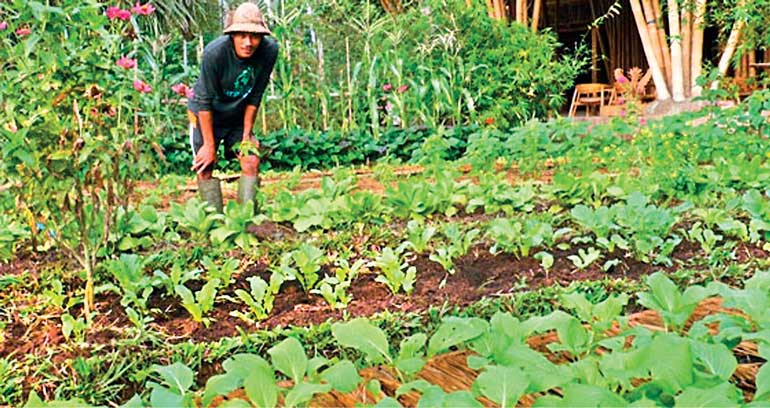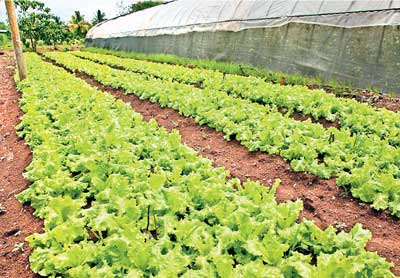Saturday Dec 13, 2025
Saturday Dec 13, 2025
Wednesday, 3 August 2016 00:00 - - {{hitsCtrl.values.hits}}
 Introduction
Introduction
Organic farming is desirable since it produces Ecological Goods and Services (EGSs). The main outputs of an organic farming system are a chemical free produce and a healthy ecosystem. Both these are very important. For many years agriculture was dominated with heavy application of chemical fertiliser, pesticides, herbicides and insecticides. These activities made the agricultural produce unsafe for consumption and the farming ecosystem unviable for farming.
For a nation driving towards healthy foods and sustainable environments, the benefits of organic farming is thus justified. However, for many years the extent of organic cultivation remained below 10% of the total agricultural land. The price of the organic produce is at least two times higher. Since the supply is stagnant for a long time, the important question to ask is ‘why’. In the explanation, let me focus on organic rice.
 The opportunity cost of producing organic produce
The opportunity cost of producing organic produce
The major difference between organic and inorganic paddy farming is the application of chemical fertiliser instead of chemical fertiliser, pesticides, insecticides, and herbicides. Therefore in providing an economic explanation, it is important to ask, ‘How much of everything else would an organic farmer need to have except for the chemicals so that he can be at the same level of production or profits as an inorganic framer’.
Research work shows that organic farmers tend to use more labour compared to inorganic farmers. Furthermore they tend to use more paddy seeds per acre. Finally they apply very high amount of organic fertiliser compared to what he would have applied if he were to do inorganic farming. Therefore the opportunity cost of organic farming, compared to inorganic farming comes from labour, seeds and fertiliser.
The important task now is to explain why these components are increasing with organic farming. Research shows that farmers tend to apply more organic fertiliser per area and that is mainly because the efficiency of the organic fertiliser is low and the nutrient uptake is also slow compared to inorganic fertiliser. Therefore for plants to absorb the required nutrients, farmers put more organic fertiliser. The research on the suitable mixture of organic fertiliser for paddy is missing. Therefore there are no recommendations.
Farmers come up with their own mixture of animal manure, leafy matter and other organic compounds. Usually, the amounts required are very high. Research showed the farmers who claimed to be organic and who use less organic fertiliser are actually using  very little amounts of inorganic fertiliser. Then as we all know, it is not organic anymore. Some farmers buy organic fertiliser from private vendors. These are synthesised organic fertiliser either imported or manufactured here. They are again costly and higher than the costs of inorganic fertiliser.
very little amounts of inorganic fertiliser. Then as we all know, it is not organic anymore. Some farmers buy organic fertiliser from private vendors. These are synthesised organic fertiliser either imported or manufactured here. They are again costly and higher than the costs of inorganic fertiliser.
Farmers use more seeds per acre or the cost of paddy seeds per acre is higher compared to inorganic framing. The interesting fact is that almost all the organic paddy farming is linked with the traditional varieties. There are farmers who cultivate new improved varieties using organic fertiliser but that component is very little. This is mainly because the organic fertiliser is much responsive to traditional rice varieties compared to new improved varieties. The cost per 1 kg of traditional paddy seed is higher than 1 kg of new improved verities.
Most of the time organic farmers have to spend money and time looking for good quality seeds therefore ‘search time cost’ is high. It is also not very easy to propagate traditional paddy seeds; it takes time and effort compared to new improved varieties. Though these traditional seeds have a high vigour, it takes time and effort to establish them in nurseries.
The cost of labour is high with the organic farming due to many reasons. The synthesis of organic fertiliser is costly. It involves farmers physically collecting all the organic matter such as cow dung, poultry manure and leafy matter and them composting or making a liquid based organic fertiliser. Most farmers prefer to do this, especially if they have enough leafy matter and livestock. But what they do not account is the time they spent on making the fertiliser.
Once the man-days involve in are calculated with wage rates the cost of labour for making the organic fertiliser by them is very high. On average the cost of organic fertiliser would increase by nearly 30% once the own labour is accounted for. The same issue is with the paddy seed production as well. The time a farmer spent on finding good quality seed will increase the cost of paddy seeds by nearly 20% and the time spent on nursery establishment will raise the cost of paddy seeds by nearly 10%. These time costs are not a significant factor in inorganic farming.
Farmers use hired labour and own labour. For most inorganic farmers the majority of labour comes as hired labour. However for majority of organic farmers, compared to inorganic farmers the use of own labour is high. For cost of cultivation surveys, most of the time farmers record accurate data only for hired labour. Hence it was common to say labour cost for inorganic framing is high. The research work that this paper is based on specifically look at the own labour cost.
Findings show that organic farmers use more own labour and once that is accounted for the labour costs were significantly higher for organic farmers. Furthermore, given same amount of own labour organic farmers use more males compared to females. This also increased the cost of own labour since the wage rate for males and females are significantly different in paddy production.
Willingness to pay is low but market price is higher
The reason for higher market price is clear with the explanation above on the opportunity cost of producing. The production of 1 kg of inorganic rice on average will be between 50-70 rupees/kg. This is aggregating across major rice varieties. However, the research shows that the cost of production for organic rice is between 150-170 rupees/kg, after accounting for opportunity cost. Therefore it is believable why farmers are selling at higher prices. However, previous studies have shown that the consumer willingness to pay for organic rice is between 90-120 rupees/kg. Therefore there is a clear difference between what consumers are willing to pay and farmers are willing to sell. Ways to close the gap is either encourage consumers to pay more for organic rice or bring down the opportunity cost. From both, latter is more practical since consumers will not move up and spent more unless the good becomes an essential one for them.
At the moment the organic rice has become an essential good for people who are representing higher income categories, and who are concerned about non-communicable diseases (NCDs) only. Though many are interested in consuming organic rice, the income constraint has pushed them to consume the substitute. Therefore it is important that opportunity cost of producing the organic rice is reduced, so that organic rice can be demanded at a lower price by a wider consumer base.
What does the market signals suggest? ‘The Certification Penalty (TCP)’
It is important to ask why consumers are not willing to pay more for organic rice. Income constrains is a major reason but that is not applicable only to organic rice. A consumer would pay a higher price if he really believes organic rice is good for certain NCDs. A consumer would also pay a higher price if he believes that organic farming is good for the environment. There is enough research being done to justify both these benefits of organic rice. Then the question is, ‘How organic is organic’.
Since there is no clear certification system available to show that organic rice is really organic, a consumer has no other market signal other than his peer recommendations and his own trust. Don’t get confused because certifications are there for export markets. My concern is on the local market. In my view, this is the main reason for a consumer to state a low willingness to pay value. The incentives are not enough for a consumer to pay a higher price. Cost of certification is high hence farmers depend on the trust and recommendations.
Realising this, the consumers will only be willing to pay less. The industry will only target a niche market. Hence the organic rice industry will hardly realise its potential. I call this ‘The Certification Penalty (TCP)’.
The way forward
In my view, there are three approaches:
1. Bring down the opportunity cost of supply
2. Encourage farmers to adopt certifications so consumers will be willing to pay more
3. Stay with the status quo and cater only a limited market.
For a lazy policy maker the best option is number (3), don’t do anything and allow organic rice to be a high-end consumer product. However, since we want to consume healthy food and are concerned with the environment (1) and (2) are the desirable options.
In order to bring down the opportunity cost of supply the interventions have to focus on the three areas where the cost is being generated: fertiliser, seeds and labour. It is clear that conventional method of organic fertiliser preparation is useless. Proper research has to be done to make recommendation on an organic fertiliser mixture. Even there we need to think innovatively. Can the research come up with a commercially viable ‘organic fertiliser product’. This can be done with the engagement of the private sector under ‘Public-Private-Partnerships’. Who would lead the research and who holds the patent for such a product is up for detail discussions.
Giving a subsidy for traditional paddy seed is an option, but it should not be another effort where farmers are given things free. Rather the subsidy should be to build the capacity of them to engage in producing their own seed paddy and then becoming sustainable in the long run. Increased cost of labour mainly comes from fertiliser and seeds therefore any actions taken against them would necessary reduce the total cost of labour in the long run.
Labour shortage and rising cost of labour is a well-documented issue. One solution is to promote or introduce more machinery. This can be again built in to a subsidy program such as a low interest loan where organic farmers can buy necessary machinery. With the approved World Bank money to the Ministry of Agriculture this is a possibility.
Final option is to promote certification among organic farmers. In order for that to happen the cost of certification has to go down. One possible way is to promote organic certification at farmer organisation level. There are several reputed organic rice brand names in the market. However they operate without organic certification. Therefore they could be encouraged for this. Once the cost of certification is shared among many farmers the unit cost increase on the price will be low. But that will be compensated with the increase in the consumer willingness to pay.
(The writer is an economist in environment and agriculture. The article is based on
a project funded by South Asian Network
for Development and Environment Economics (SANDEE).
The writer can be reached via
[email protected]).